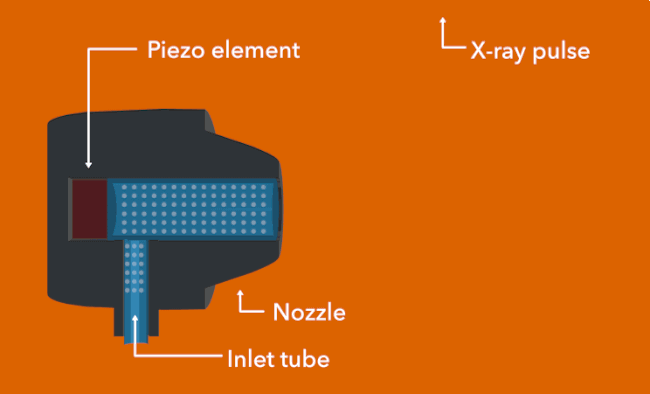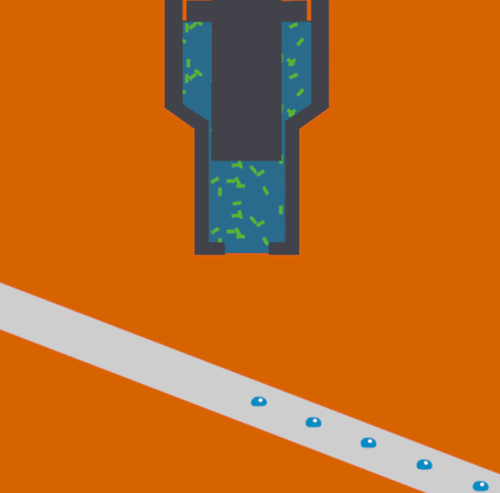Droplet Injectors
Clouds created from a plum of droplets containing a sample can be focused into a stream of particles with an aerodynamic lens stack.
How it works
The lens stack for the droplet method ends in a vacuum system, requiring a pressure gradient from the atmosphere, where the droplet plume is generated down to the interaction point.
As the droplets migrate and are focused through a series of diaphragms (lenses), they also start to dehydrate. If tuned properly, there will be a stream of dehydrated particles focused down to dozens of microns at the interaction point. This method is most typically associated with single-particle imaging (SPI) initiative experiments.

Ideally, if a sample-containing droplet could be generated and placed right into the interaction point, it would be the ideal delivery method to maximize the XFEL's pulse structure and minimize the sample wasted between pulses.
Droplet injectors for atmospheric experiments
Piezoelectric droplet generators, like commercial inkjet printers, have been used in atmospheric experiments. These droplet generation devices are extremely sensitive to the fluid properties of the ejecting slurry (e.g., surface tension, viscosity, suspended particle size).

Droplet injectors for non-vacuum experimental geometries
For non-vacuum experimental geometries, the droplet method has been demonstrated via stroboscopic imaging. Fuller et al. have developed a combined approach where droplets are ejected onto a fixed-target-like tape system.
The tape acts as a conveyor belt, allowing droplet spacing and controlling the speed of the tape to give known time delays for excitement and probe experiments (e.g., photosensitive systems for laser-excited pump-probe experiments and ambient-sensitive systems where ambient gases or ambient conditions can activate sample changes).
Although the tape in the delivery system is not directly in the interaction point, it can still produce background signals.

Pros and Cons of Droplet Injectors
| Pros | Cons | Ideal For |
|---|---|---|
• No wasted sample in between pulses if synchronized • Can accommodate larger crystals • Compatible with time-resolved experiments • Works better with non-crystalline systems • Works well between lens stack and vacuum systems
| • Extremely sensitive droplet generation (to fluid/slurry properties and variations in the meniscus) • Difficult to time droplets to pulse (lens stack is not able to be synchronized with pulses) • Complicated for in-vacuum operation (compatible lens stack can have high vacuum pressure loads) • Large volume droplets • Deceptively high sample consumption rates despite being efficient (e.g., 80 μm droplets at 120 Hz consume ~2 μL/min. This is a typical size for 10-20 μm crystals.) • Needs a buffer exchange for lens stack (typically into 25 mM ammonium acetate buffer for increased fluid volatility) | • Large samples (>50 μm) (require larger drops and may easily clog liquid lines and cause more delivery problems) • Small samples (instead of suspended slurries) • Low sample quantity (if the size and rate are small enough) • Experiments that do not require vacuum conditions (lens stacks require pressure gradient into vacuum) • Experiments that require more open/complex geometries
|
